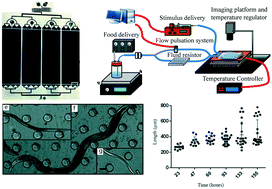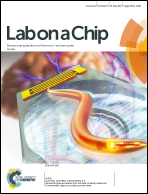Microfluidic platform with spatiotemporally controlled micro-environment for studying long-term C. elegans developmental arrests†
Abstract
Animals' long-term survival is dependent on their ability to sense, filter and respond to their environment at multiple timescales. For example, during development, animals integrate environmental information, which can then modulate adult behavior and developmental trajectory. The neural and molecular mechanisms that underlie these changes are poorly understood. C. elegans is a powerful model organism to study such mechanisms; however, conventional plate-based culturing techniques are limited in their ability to consistently control and modulate an animal's environmental conditions. To address this need, we developed a microfluidics-based experimental platform capable of long-term culture of populations of developing C. elegans covering the L1 larval stage to adulthood, while achieving spatial consistency and temporal control of their environment. To prevent bacterial accumulation and maintain optimal flow characteristics and nutrient consistency over the operational period of over one hundred and fifty hours, several features of the microfluidic system and the peripheral equipment were optimized. By manipulating food and pheromone exposure over several days, we were able to demonstrate environmental-dependent changes to growth rate and entry to dauer, an alternative developmental state. We envision this system to be useful in studying the mechanisms underlying long timescale changes to behavior and development in response to environmental changes.



 Please wait while we load your content...
Please wait while we load your content...